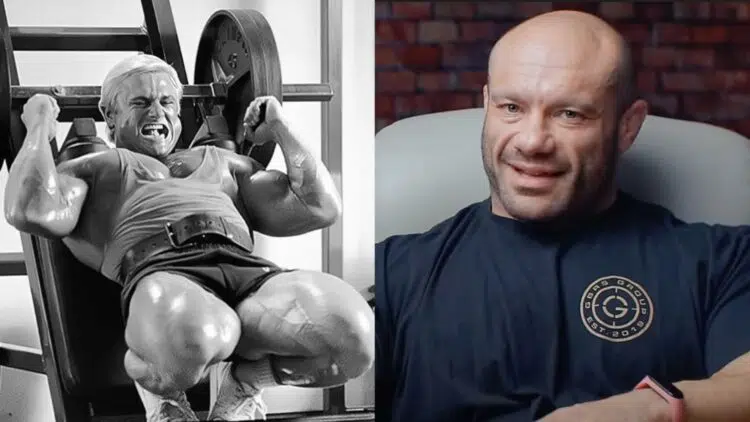Exercise scientist Dr. Mike Israetel is taking a closer look at how bodybuilding icon Tom Platz approached training. In his latest endeavor shared via YouTube on September 27, 2024, Dr. Israetel examined the leg workout technique and intensity of Platz. He also laid out lessons that we can learn from how he went about pushing his physical limits.
Tom Platz is revered in the bodybuilding community, not just for his hardcore training style, but due to how well he was able to motivate others. Although Platz never laid claim to a Mr. Olympia title, he built a sterling résumé, testing himself against stars such as Franco Columbu, Chris Dickerson, and Samir Bannout.
Despite pushing himself to the brink of exhaustion on the regular, Platz’s workout methods are proven. He boasts outstanding longevity today, having showcased his shredded quads at the age of 69. His prime years were one-of-a-kind, which has led physiologist Dr. Israetel to break down his leg routine to provide fans with a better understanding of how to maximize training progress.
Learning from ‘The Quadfather’: Exercise Scientist Breaks Down Tom Platz’s Leg Training
To begin, Dr. Israetel took a look at the intensity Platz was known for bringing to his training sessions.
Level Up Your Fitness: Join our 💪 strong community in Fitness Volt Newsletter. Get daily inspiration, expert-backed workouts, nutrition tips, the latest in strength sports, and the support you need to reach your goals. Subscribe for free!
“Not for a lack of trying did Tom Platz ever underachieve,” says Israetel. “Your fear of just one thing, maybe two, that one thing is pain. The other thing is failure.
Maybe you won’t be able to get the reps that you set in stone for yourself and that will send you down a mental cascade of realizing that you’re never going to become jacked because you don’t have what it takes. That last part is mostly for insane people, I wouldn’t even bother with that whole thing but do your fucking best. But if you’re doing your best, pain is mandatory.”
Looking at Platz performing lying leg curls, Israetel examined his form and offered advice to lifters aiming to maximize results on this exercise.
“Okay. Again, intensity amazing. Slamming the eccentric down discourteous to other members at the gym but whatever we’re all there for a good time. Discourteous to the owner of the equipment although the machines are made of metal so no big deal.”
Dr. Israetel said slamming the eccentric of lying leg curls could limit the stimulus you receive from the movement and increase your chances of injury.
“Discourteous to the probability of injuring your hamstrings, yes. Discourteous to the stimulus received at the bottom of that eccentric phase which you completely miss out on because you go into the next rep? Yeah. Not an ideal technique.”
He also examined how Tom Platz went about performing calf raises.
“Tom was going to do whatever the fuck needed to be done to grow muscle. Oh my god. I’m going to flat-out tell you guys I don’t try that hard. Real talk.”
Moving on, he gets into the single lift that made Tom Platz a larger-than-life icon: the barbell squat.
“He was so good at these that at one point with I think just barely a skinny little squat suit which in the 80s did hardly dick for you, he is on video squatting 500 pounds for I believe 21 or 23 reps or something like that, a feat that with that technique, I’ve never seen replicated. 525 for 23. I mean, high bar, to depth with minimal equipment that’s insane. It’s insane.”
He explored the different parts of the body utilized during the squat.
“As long as your lower back is tight and your core is a little bit contracted and as long as you’re moving slowly and deliberately and you don’t let your back fold over that’s probably good enough you don’t have to have whole body tightness for hypertrophy work but you definitely don’t want to be loosey goosey.”
Since Platz would sometimes bounce during his squat repetitions, Israetel provided insight into whether or not that was a good idea during training.
“I wouldn’t bounce out of the hole but you want to stay tight and a little bounce is totally cool. A big bounce is probably a combination of not-so-safe and not nearly as stimulative for your muscles as it otherwise could have been.”
Next, he assessed the execution and technique used by Platz during repetitions of machine hack squats. Although Israetel believes Platz turned the movement more into a sissy squat, he mentioned that performing them slower on the way down might produce more optimal results.
“This is turning from a hack squat into a sissy squat into a proper rigid body leg extension that really targets that middle of your quad pretty much the best of any exercise or top three and then you come all the way back up. This is one hell of a movement. I would do it a little bit slower on the way down.”
“Some good technique, some maybe not ideal technique, effort. If you think you’re not training hard, now you’ve seen the highest bar in the world for training,” he shared.
This was far from Dr. Israetel’s first time analyzing the workout tendencies of a bodybuilding legend. He’s offered learning lessons, critiques, and insights into the training of former Mr. Olympias Ronnie Coleman, Jay Cutler, Phil Heath, and Dorian Yates.
Dr. Israetel hopes to provide fans with an effective training foundation by unearthing exercise methods used by all-time greats. While Platz didn’t always execute perfect technique, it’s evident that the degree of intensity he brought to workouts played a major role in his lasting success.
RELATED: Exercise Scientist Breaks Down and Critiques Chris Bumstead’s Upper Body Training









